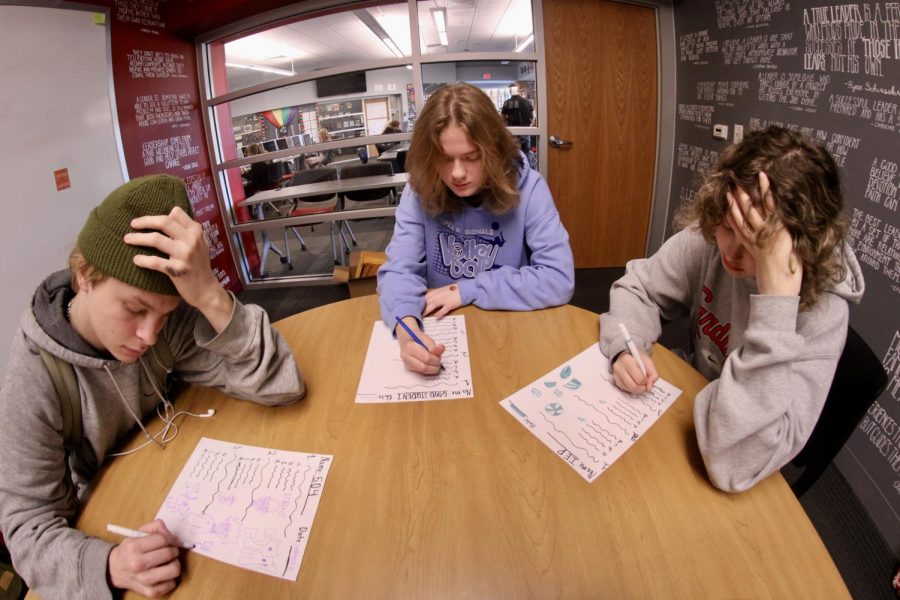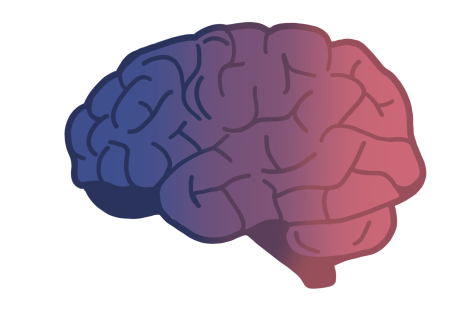IDEAs in Self-Advocacy
Students Ryder George-Lander, Annalise Bancks, and Gray Campbell struggle with a test.
Right foot tapping, left hand wiggling a pencil, eraser bouncing off the wooden desk he’s sitting at. In the corner of the room sits Ryder George-Lander, Senior. The grayish booklet in front of him is marked with three-letters high schoolers are all too familiar with: A.C.T. His peers down the hallway rush to fill in the green bubbles on their answer sheets before time runs out, while George-Lander is shrugging off his nervousness.
According to the Federal Department of Education, George-Lander is one of 7.2 million students whose schools create plans to help close the gap between neurotypical students and those with learning disabilities or special education needs. After being diagnosed with ADHD, he received accommodations under the 504 section of the Individuals with Disabilities Education Act (IDEA). The 504 section refers to individuals who do not need Individualized Education Plans (IEPs), but still need accommodations in school.
Under most circumstances, George-Lander is able to use the conditions of his 504, but some teachers still prevent him from using his plan to its fullest extent.
“I’m supposed to go on walks,” George-Lander said. “If I’m antsy in class I just get up and go, but some [teachers] won’t let me.”
George-Lander uses his 504 plan to get separate test-taking rooms, as well as extended time on the A-C-T. The extra time helped him achieve a good score on the standardized exam.
“I remember using it a lot in middle school to take the test somewhere else, so [I] could focus,” George-Lander said. “It always helped me stay focused, my grades definitely went up because of [my] 504.”
“Teachers make me feel stupid sometimes,” Campbell said. “This teacher I had [freshman] year kept stopping in the middle of class to single me out. It was really embarrassing.”
— Gray Campbell
While largely positive, George-Lander’s experience with a 504 plan represents only a portion of students with learning plans. Maggie Brinkman, freshman, was unable to use the full extent of her IEP after moving to Kirkwood until she spoke to her caseworker.. IDEA specifies that districts are to reuse the exact same plan when a student transfers until a new one is drafted.
“It took a while for mine to transfer over, so I wasn’t getting all the [accomodations] I was supposed to,” Brinkman said. “There’s a lot of self advocating involved.”
Gray Campbell, junior, receives accommodations for dyscalculia under the IEP section of IDEA. Despite having an IEP since freshman year, Campbell still finds it hard to get help outside of school.
“I get help at school, but I have to ask for it every time,” Campbell said. “There’s not a lot of help outside of school, so I get my assignments done super late.”
While receiving instruction, Campbell said she was often made to feel inferior by teachers. Ridicule from teachers and peers was something IDEA was designed to protect against.
“Teachers make me feel stupid sometimes,” Campbell said. “This teacher I had [freshman] year kept stopping in the middle of class to single me out. It was really embarrassing.”
Campbell said that she has to frequently fight for the best uses of her IEP. This happened the most when it came to getting help in school.
“I go to my case worker with problems [I] have,” Campbell said. “There’s a lot of self-advocating involved in the process, I have to fight to get help inside and outside of school.”
Campbell said the need to self advocate frustrates her. Combined with the lack of resources outside of school, she said she’s overwhelmed.
“I have to do a bunch of homework outside of school,” Campbell said. “And I don’t have [many] resources outside of school. I try to get it done in class, but if I don’t I just kind of give up.”
Your donation will support the student journalists of Kirkwood High School. Your contribution will allow us to purchase equipment and cover our annual website hosting costs.

He/Him
Hobbies and Interests: watching F1, collecting subway maps, watching the Seattle Kraken and drinking Monster
Favorite movie: Inception
Favorite...

She/Her
Hobbies and Interests: field hockey, best buddies, mock trial, art, photography
Favorite movie: Jumanji Welcome to the Jungle
Favorite...

















![“[Fashion is] a means to express myself,” Ezra Birman, senior, said. “I can’t imagine a world where I didn’t dress like this.”
Art by Ally Hudson](https://www.thekirkwoodcall.com/wp-content/uploads/2022/03/ezrapolaroid-e1646944084982-475x318.png)

